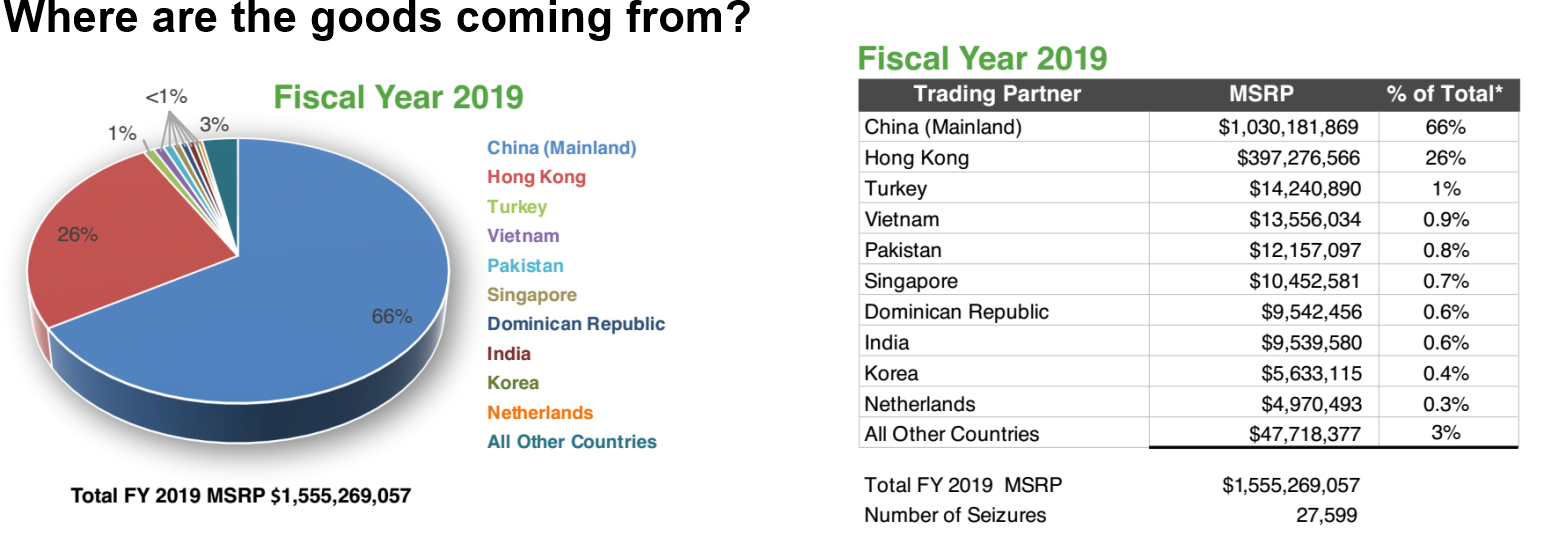Protecting Intellectual Property Rights At The Border
This article will look at one threat to Intellectual Property Rights [IPR] which is the flow of counterfeit goods into the U.S. and how IP owners can work with the U.S. Customs and Border Protection (CBP) to reduce losses.
Summary: In 2019, there were 27,599 seizures of counterfeit goods by U.S. Customs worth $1.55 billion if sold with the top categories being watches, jewelry, apparel and accessories.
Summary: In 2019, 92% of the goods came from China and it’s special administration region Hong Kong worth $1.4 billion.
Summary: In 2019, 57% of the goods seized came via Express transport.
How to Best Protect Your IP at the Border: The e-Recordation program protects registered Trademarks and Copyrights by allowing an IPR owner to create a product identification guide to assist CBP in identifying infringing goods crossing the border. This program is given priority by the CBP and further information about it can be found here or by following the link below.
If protection for design and utility patents is desired, it can be obtained by filing with the U.S. International Trade Commission (USITC) which can issue an exclusion order that can be enforced by the CBP. It is suggested to IPR owners of design and utility patents that a trademark be applied for so it can be recorded with Customs as this seems to be their primary enforcement tool.
Want to continue the discussion here? If you found this article to be informative please let us know by clicking the LinkedIn Like button and help spread the information by sharing with your network. Also, We’d love to hear your thoughts on this article in the comments.
Should you have a need for patent drawings, please consider Gallagher’s Patent Drafting. We strive to go above and beyond your typical IP Illustration service with excellent work and over 34 years of experience drawing IP from all industries. Feel free to connect with us by email at patentdrawings@gpdcorp.com and by visiting us online at www.gpdcorp.com
Sources:
Working with CBP to Help Protect Your Intellectual Property Rights
Prepared by: U.S. Customs and Border Protection
accessed: March, 2021
Working_with_CBP_to_Help_Enforce_Your_Intellectual_Property_Rights[1].PDF
Intellectual Property Rights
Fiscal Year 2019 Seizure Statistics
Prepared by: U.S. Customs and Border Protection
accessed: March, 2021
FY 2019 IPR Statistics Book (Final).PDF
Below is a response to our CBP inquiry concerning how they protect US design and utility patents.
On Wed, Mar 3, 2021 at 12:16 PM David Gallagher <david@gpdcorp.com> wrote:
———- Forwarded message ———
From: VAN HORN, ALAINA <ALAINA.VANHORN@cbp.dhs.gov>
Date: Wed, Mar 3, 2021 at 11:48 AM
Subject: RE: e-Recordation Program
To: IPRRQUESTIONS <IPRRQUESTIONS@cbp.dhs.gov>, david@gpdcorp.com
Hello Mr. Gallagher:
Thank you very much for your inquiry.
U.S. Customs and Border Protection (CBP) is the primary federal agency responsible for securing America’s borders, including the protection of intellectual property rights, which guards against the infringement of U.S. patents, copyrights, and trademarks. At the border, CBP is authorized to exclude, detain, seize, forfeit, and ultimately destroy imported merchandise that infringes federally registered and recorded trademarks and copyrights and/or is covered by an exclusion order issued by the U.S. International Trade Commission. Trademarks and copyrights that have registered with the United States Patent and Trademark Office (USPTO) or the United States Copyright Office (USCOP), and has subsequently been recorded with CBP, receive enforcement priority. CBP does not have independent authority to enforce patents at the border unless the imported merchandise is covered by an exclusion order or Seizure and Forfeiture Order (SFO) issued by the U.S. International Trade Commission. Further information regarding CBP’s IPR border enforcement authority may be found at https://www.cbp.gov/trade/priority-issues/ipr/protection.
U.S. IP right holders may file a Section 337 complaint with the U.S. International Trade Commission (USITC) to prevent the importation of infringing articles. Section 337 declares the infringement of certain statutory IPR and other forms of unfair competition in import trade to be unlawful practices. Most Section 337 investigations involve allegations of patent or registered trademark infringement, but they can involve copyright infringement and trade secret violations as well. In the event that the USITC determines that Section 337 has been violated, it may issue an exclusion order barring the products at issue from entry into the United States, as well as a cease and desist order directing the violating parties to cease certain actions. See https://www.usitc.gov/intellectual_property.htm for further information.
The USITC also has a Trade Remedy Assistance Office (TRAO) that provides information to small businesses concerning the remedies and benefits available under U.S. trade laws and provides technical and legal assistance and advice to eligible small businesses to assist them in preparing and filing Section 337 complaints. https://www.usitc.gov/small_business_assistance.htm
Alaina van Horn
Chief, Intellectual Property Rights Branch
Regulations and Rulings | Office of Trade | CBP
From: David Gallagher <david@gpdcorp.com>
Sent: Wednesday, March 3, 2021 10:11 AM
To: IPRRQUESTIONS <IPRRQUESTIONS@cbp.dhs.gov>
Subject: e-Recordation Program
Hi,
I have read about your program and understand it will protect Trademarks and Copyrights on various products.
My concern is as follows: how does Customs protect products that have a US design or utility patent? Does Customs have any sort of system in place similar to the protect offered for Trademarks and Copyrights?
Your response might be included in a newsletter my company sends out.
Thank you for your time.
David
David Gallagher
Gallagher’s Patent Drafting
78B Sagamore Street
Quincy, MA 02171-1955
Phone: 617.328.5888
Web: https://gpdcorp.com/




